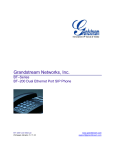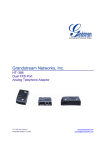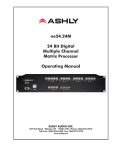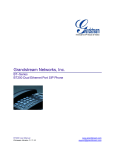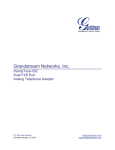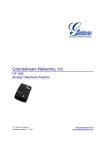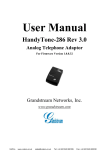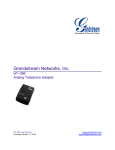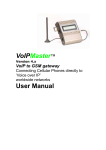Download Grandstream Networks HT-496 User's Manual
Transcript
Grandstream Networks, Inc. HT–496 Dual FXS Port Analog Telephone Adaptor HT–496 User Manual Firmware Version 1.0.3.64 VoIPon www.voipon.co.uk www.grandstream.com [email protected] [email protected] Tel: +44 (0)1245 808195 Fax: +44 (0)1245 600030 TABLE OF CONTENTS HT-496 User Manual WELCOME.................................................................................................................................................... 4 INSTALLATION............................................................................................................................................ 5 EQUIPMENT PACKAGING............................................................................................................................... 5 CONNECTING YOUR ATA ............................................................................................................................. 5 FIGURE 1: CONNECTING THE HT– 496......................................................................................................... 5 FIVE EASY STEPS TO INSTALL THE HT–496 ................................................................................................... 6 SAFETY COMPLIANCES................................................................................................................................. 6 WARRANTY.................................................................................................................................................. 6 PRODUCT OVERVIEW ................................................................................................................................ 7 KEY FEATURES ............................................................................................................................................ 7 BASIC OPERATIONS .................................................................................................................................. 9 GET FAMILIAR WITH VOICE PROMPT ............................................................................................................. 9 PLACING A PHONE CALL ............................................................................................................................. 11 PHONE OR EXTENSION NUMBERS ............................................................................................................... 11 DIRECT IP CALLS ....................................................................................................................................... 11 CALL HOLD ................................................................................................................................................ 11 CALL WAITING ........................................................................................................................................... 11 CALL TRANSFER ........................................................................................................................................ 11 3-WAY CONFERENCING .............................................................................................................................. 12 CALL FEATURES ...................................................................................................................................... 13 T.38 FAX ................................................................................................................................................... 13 LED LIGHT PATTERN INDICATION ............................................................................................................... 14 CONFIGURATION GUIDE ......................................................................................................................... 15 CONFIGURING HT–496 THROUGH VOICE PROMPT....................................................................................... 15 DHCP MODE ............................................................................................................................................ 15 STATIC IP MODE...................................................................................................................................... 15 FIRMWARE SERVER IP ADDRESS ................................................................................................................ 15 CONFIGURATION SERVER IP ADDRESS ....................................................................................................... 15 UPGRADE PROTOCOL ................................................................................................................................ 15 FIRMWARE UPGRADE MODE ....................................................................................................................... 15 WAN PORT WEB ACCESS .......................................................................................................................... 15 CONFIGURING HT–496 WITH WEB BROWSER ............................................................................................. 15 ACCESS THE WEB CONFIGURATION MENU .................................................................................................. 15 FROM THE LAN PORT:................................................................................................................................ 15 FROM THE WAN PORT: .............................................................................................................................. 16 END USER CONFIGURATION ....................................................................................................................... 16 ADVANCED USER CONFIGURATION ............................................................................................................. 20 SAVING THE CONFIGURATION CHANGES ..................................................................................................... 26 REBOOTING THE HT–496 FROM REMOTE ................................................................................................... 26 CONFIGURATION THROUGH A CENTRAL SERVER .......................................................................................... 26 SOFTWARE CONFIGURATION ................................................................................................................ 27 FIRMWARE UPGRADE THROUGH TFTP/HTTP ............................................................................................. 27 IVR METHOD ............................................................................................................................................. 27 NO LOCAL TFTP SERVER .......................................................................................................................... 27 CONFIGURATION FILE DOWNLOAD .............................................................................................................. 28 FIRMWARE AND CONFIGURATION FILE PREFIX AND POSTFIX ........................................................................ 28 MANAGING FIRMWARE AND CONFIGURATION FILE DOWNLOAD ..................................................................... 28 RESTORE FACTORY DEFAULT SETTING.............................................................................................. 29 GLOSSARY OF TERMS ............................................................................................................................ 30 Grandstream Networks, Inc. VoIPon www.voipon.co.uk HT–496 User Manual Firmware 1.0.3.64 [email protected] Tel: +44 (0)1245 808195 Page 2 of 33 Last Updated: 1/2007 Fax: +44 (0)1245 600030 TABLE OF FIGURES HT–496 User Manual FIGURE 1: CONNECTING THE HT– 496 ............................................................................................................ 5 FIGURE 2: CONFIGURING THE HT–496 ............................................................................................................ 6 FIGURE 3: SCREENSHOT OF CONFIGURATION LOG- IN PAGE ........................................................................... 16 FIGURE 4: SCREENSHOT OF ADVANCED USER CONFIGURATION LOG- IN PAGE ................................................ 20 FIGURE 5: SCREENSHOT OF SAVE CONFIGURATION PAGE ............................................................................... 26 TABLE OF TABLES HT–496 User Manual TABLE 1: DEFINITIONS OF THE HT–496 CONNECTORS ..................................................................................... 5 TABLE 2: HT–496 TECHNICAL SPECIFICATIONS ............................................................................................... 7 TABLE 3: HT–496 HARDWARE SPECIFICATIONS ............................................................................................... 8 TABLE 4: HT–496 IVR MENU DEFINITIONS ...................................................................................................... 9 TABLE 5: HT–496 CALL FEATURE DEFINITIONS ............................................................................................. 13 TABLE 6: HT–496 LED DEFINITIONS ............................................................................................................. 14 TABLE 7: HT–496 BASIC CONFIGURATION SETTINGS DEFINITIONS ................................................................. 17 TABLE 8: HT–496 DEVICE STATUS PAGE DEFINITIONS................................................................................... 19 TABLE 9: HT–496 ADVANCED CONFIGURATION PAGE DEFINITIONS ................................................................ 21 TABLE 10: HT–496 INDIVIDUAL ACCOUNT SETTINGS DEFINITIONS .................................................................. 23 CONFIGURATION GUI INTERFACE EXAMPLES HT–496 User Manual (http://www.grandstream.com/user_manuals/GUI/GUI_HT496.rar) 1. 2. 3. 4. 5. 6. SCREENSHOT OF ADVANCED USER CONFIGURATION PAGE SCREENSHOT OF AUDIBLE TONE CONFIGURATION PAGE SCREENSHOT OF BASIC SETTINGS CONFIGURATION PAGE SCREENSHOT OF FXS PORT 1 CONFIGURATION LOGIN PAGE SCREENSHOT OF FXS PORT 2 CONFIGURATION PAGE SCREENSHOT OF STATUS CONFIGURATION LOG IN PAGE Grandstream Networks, Inc. VoIPon www.voipon.co.uk HT–496 User Manual Firmware 1.0.3.64 [email protected] Tel: +44 (0)1245 808195 Page 3 of 33 Last Updated: 1/2007 Fax: +44 (0)1245 600030 Welcome Thank you for purchasing the Grandstream HT–496, the affordable, feature rich Analog Telephone Adaptor designed for both the residential and business user. HandyTone-496 is a next generation dual-port SIP IAD for Internet data, voice, and fax. The HT–496 is a full feature voice and fax-over IP device that offers a high-level of integration including an integrated router, NAT, DHCP server, dual port FXS telephone gateway, market-leading sound quality, rich functionalities, and a compact and lightweight design. The HT–496 is compact, works with any analog or cordless phone and fax machines and offers the simplicity of plug and dial. Caution: Changes or modifications to this product not expressly approved by Grandstream, or operation of this product in any way other than as detailed by this User Manual, could void your manufacturer warranty. • This document is contains links to Grandstream GUI Interfaces. Please download these examples http://www.grandstream.com/user_manuals/GUI/GUI_HT496.rar as your reference. • This document is subject to change without notice. The latest electronic version of this user manual is available for download @:http://www.grandstream.com/user_manuals/HT-496_User_Manual.pdf. • Reproduction or transmittal of the entire or any part, in any form or by any means, electronic or print, for any purpose without the express written permission of Grandstream Networks, Inc. is not permitted. Grandstream Networks, Inc. VoIPon www.voipon.co.uk HT–496 User Manual Firmware 1.0.3.64 [email protected] Tel: +44 (0)1245 808195 Page 4 of 33 Last Updated: 1/2007 Fax: +44 (0)1245 600030 Installation EQUIPMENT PACKAGING The HT–496 ATA package contains: • • • One HT–496 Main Case One Universal Power Adaptor One Ethernet Cable CONNECTING YOUR ATA The HT–496 is easy to configure. The HT–496 has two FXS ports. Each FXS port can have a separate SIP account. This is a key feature of HT–496. Both ports can make calls concurrently. FIGURE 1: CONNECTING THE HT– 496 RJ-45 10M Ethernet LAN/WAN RJ-11 FXS Port RJ-11 FXS Port (Phone) +5V/1200mA RJ-11 FXS Port (Phone) LED Button (green/red) Table 1: Definitions of the HT–496 Connectors Power Cable Power adapter connection WAN Port (RJ-45) Connect to the internal LAN network or router. LAN Port (RJ-45) Connect the LAN port with an Ethernet cable to your PC. PHONE1 (RJ-11) Connect analog phone / fax machine to FXS port. PHONE2 (RJ-11) Connect analog phone / fax machine to FXS port. Grandstream Networks, Inc. VoIPon www.voipon.co.uk HT–496 User Manual Firmware 1.0.3.64 [email protected] Tel: +44 (0)1245 808195 Page 5 of 33 Last Updated: 1/2007 Fax: +44 (0)1245 600030 FIVE EASY STEPS TO INSTALL THE HT–496 1. Connect a standard touch-tone analog telephone (or fax machine) to first FXS port. 2. Connect another standard touch-tone analog telephone (or fax machine) to second FXS port. 3. Insert the Ethernet cable into the WAN port of HT–496 and connect the other end of the Ethernet cable to an uplink port (a router or a modem, etc.) 4. Connect a PC to the LAN port of HT–496. 5. Insert the power adapter into the HT–496 and connect it to a wall outlet. FIGURE 2: CONFIGURING THE HT–496 Internet ADSL/Cable Modem Ethernet Analog Phone Analog Phone WAN FXS FXS Cordless Phone LAN Fax Cordless Phone Fax SAFETY COMPLIANCES The HT–496 complies with FCC/CE and various safety standards. The HT–496 power adaptor is compliant with UL standard. Only use the universal power adapter provided with the HT–496 package. The manufacturer’s warranty does not cover damages to the phone caused by unsupported power adaptors. WARRANTY If you purchased your HT–496 from a reseller, please contact the company where you purchased your phone for replacement, repair or refund. If you purchased the product directly from Grandstream, contact your Grandstream Sales and Service Representative for a RMA (Return Materials Authorization) number before you return the product. Grandstream reserves the right to remedy warranty policy without prior notification. Warning: Please do not use a different power adaptor with the HT–496 as it may cause damage to the products and void the manufacturer warranty. Grandstream Networks, Inc. VoIPon www.voipon.co.uk HT–496 User Manual Firmware 1.0.3.64 [email protected] Tel: +44 (0)1245 808195 Page 6 of 33 Last Updated: 1/2007 Fax: +44 (0)1245 600030 Product Overview HandyTone-496 is a next generation dual-port SIP IAD for Internet data, voice, and fax. KEY FEATURES Ethernet Ports DHCP FXS Port PSTN Pass – through Voice Mail Indicator Voice Codec Remote Configuration 2 RJ45 (LAN) Server/ Client 2 No Yes iLBC, G.723, G.711, G.729, G.726, T.38 TFTP/HTTP TABLE 2: HT–496 Technical Specifications Lines/SIP Accounts Protocol Support(1) 2 lines / 2 SIP accounts SIP 2.0 (RFC 3261), TCP/UDP/IP, RTP/RTCP, HTTP, ARP/RARP, ICMP, DNS, DHCP, NTP, TFTP, PPPoE protocols Feature Keys LAN/WAN Interface Device Management 1 button RJ-45 10 Mbps Web interface or via secure (AES encrypted) central configuration file for mass deployment Support Layer 2 (802.1Q, VLAN, 802.1p) and Layer 3 QoS (ToS, DiffServ, MPLS) Auto/manual provisioning system NAT-friendly remote software upgrade (via TFTP/HTTP) for deployed devices including behind firewall/NAT Advanced Digital Signal Processing (DSP) Dynamic negotiation of codec and voice payload length Support for G.723,1 (5.3K/6.3K), G.729A, G.711 µ/A, G.726, and iLBC codecs In-band and out-of-band DTMF ((in audio, RFC2833, SIP INFO) Silence Suppression, VAD (voice activity detection), CNG (comfort noise generation), ANG (automatic gain control) Adaptive jitter buffer control Packet delay & loss concealment Caller ID display or block, Call waiting caller ID, Call waiting/flash, Call transfer, hold, forward, mute, 3-way conferencing Manual or dynamic host configuration protocol (DHCP) network setup; RTP and NAT support traversal via STUN DIGEST authentication and encryption using MD5 and MD5-sess Stylish and compact design; small universal power supply, ideal for travel Audio Features Call Handling Features Network and Provisioning Security Physical Design Grandstream Networks, Inc. VoIPon www.voipon.co.uk HT–496 User Manual Firmware 1.0.3.64 [email protected] Tel: +44 (0)1245 808195 Page 7 of 33 Last Updated: 1/2007 Fax: +44 (0)1245 600030 TABLE 3: HT–496 Hardware Specifications LAN Interface 1 x RJ45 10 Mbps WAN Interface 1 x RJ45 10 Mbps FXS phone port 2 x FXS Button 1 LED Green and red / solid state & blinking state Universal Switching Power Adaptor Input: 100-240VAC 50-60 Hz Output: +5VDC, 1200mA UL certified Dimension 70mm (W) x 130mm (D) x 27mm (H) Weight 0.6lbs (0.3kg) Temperature 40 - 130ºF / 5 – 45ºC Humidity 10% - 90% (non-condensing) Compliance FCC/CE/C-Tick Grandstream Networks, Inc. VoIPon www.voipon.co.uk HT–496 User Manual Firmware 1.0.3.64 [email protected] Tel: +44 (0)1245 808195 Page 8 of 33 Last Updated: 1/2007 Fax: +44 (0)1245 600030 Basic Operations GET FAMILIAR WITH VOICE PROMPT HT–496 stores a voice prompt menu (Interactive Voice Response or IVR) for quick browsing and simple configuration. The IVR menu and the LED button work with the FXS port 1 only. Pick up the handset and press the button on the HT–496 or dial “***” to use the IVR menu, TABLE 4: HT–496 IVR Menu Definitions Menu Voice Prompt Options Main Menu “Enter a Menu Option” Press “*” for the next menu option Press “#” to return to the main menu Enter 01-06, 47, 86, 99 menu options 01 “DHCP Mode”, Press “9” to toggle the selection “Static IP Mode” If using “Static IP Mode”, configure the IP address information using menus 02 to 05. If using “Dynamic IP Mode”, all IP address information comes from the DHCP server automatically after reboot. 02 “IP Address “ + IP address The current WAN IP address is announced If using “Static IP Mode”, enter 12-digit new IP address. 03 “Subnet “ + IP address Same as menu 02 04 “Gateway “ + IP address Same as menu 02 05 “DNS Server “ + IP address Same as menu 02 07 Preferred Vocoder Press “9” to move to the next selection in the list: • PCM U / PCM A • G.723 • G.729 • G.726 • iLBC 12 WAN Port Web Access Press “9” to toggle between enable / disable 13 Firmware Server IP Address Shows current Firmware Server IP address. Enter 12digit new IP address. 14 Configuration Server IP Address Announces current Config Server Path IP address. Enter 12-digit new IP address. 15 Upgrade Protocol Upgrade protocol for firmware and configuration update. Press “9” to toggle between TFTP / HTTP 16 Firmware Version Firmware version information. 17 Firmware Upgrade Firmware upgrade mode. Press “9” to toggle among the following three options: - always check - check when pre/suffix changes Grandstream Networks, Inc. VoIPon www.voipon.co.uk HT–496 User Manual Firmware 1.0.3.64 [email protected] Tel: +44 (0)1245 808195 Page 9 of 33 Last Updated: 1/2007 Fax: +44 (0)1245 600030 - never upgrade 47 “Direct IP Calling” Enter a 12 digit IP address to make a direct IP call, after dial tone. (See “Make a Direct IP Call”.) 99 “RESET” Press “9” to reboot the device; or Enter encoded MAC address to restore factory default setting (See “Restoring Factory Settings”) “Invalid Entry” Automatically returns to main menu NOTE: 1. Pressing the button during the IVR session will prompt a dial tone and the menu goes directly to “Direct IP Call” option. 2. “*” shifts down to the next menu option “#” returns to the main menu “9” functions as the ENTER key and will confirm an option 3. All entered digit sequences have known lengths - 2 digits for menu option and 12 digits for IP address. Grandstream Networks, Inc. VoIPon www.voipon.co.uk HT–496 User Manual Firmware 1.0.3.64 [email protected] Tel: +44 (0)1245 808195 Page 10 of 33 Last Updated: 1/2007 Fax: +44 (0)1245 600030 PLACING A PHONE CALL PHONE OR EXTENSION NUMBERS 1. Dial the number directly and wait for 4 seconds (Default “No Key Entry Timeout”); or 2. Dial the number directly and press # (Use # as dial key” must be configured in web configuration). Examples: 1. Dial an extension directly on the same proxy, (e.g. 1008), and then press the # or wait for 4 seconds. 2. Dial an outside number (e.g. (626) 666-7890), first enter the prefix number (usually 1+ or international code) followed by the phone number. Press # or wait for 4 seconds. Check with your VoIP service provider for further details on prefix numbers. DIRECT IP CALLS Direct IP calling allows two parties with VoIP devices (e.g. a HT–496and another VoIP Device), to talk to each other in an ad hoc fashion without a SIP proxy. Direct IP calls are possible if: a) Both VoIP devices use a public IP address; or b) Both VoIP devices are on the same LAN using private IP addresses, or c) Both VoIP devices can be connected through a router using public or private IP addresses (with necessary port forwarding or DMZ). To make a Direct IP Call, use either the handset or the speakerphone. Access the IVR using “***”, the button on the HT–496or “47”. After dial tone, enter a 12-digit target IP address to place a call. Destination ports can be specified by using “*4” (encoding for “:”) followed by the port number. Examples: a) If the target IP address is 192.168.0.160, enter the 12-digit IP address (e.g. 1921680160) after the voice prompt followed by the “#” key or wait for 4 seconds. The default destination port 5060 is used if no port is specified. b) If the target IP address/port is 192.168.1.20:5062, enter the 12 digit IP address + *45062 (e.g. 1921680160*45062) after the voice prompt followed by the “#” key or wait for 4 seconds. CALL HOLD Press the “flash” button to place a caller on hold. Press the “flash” button again to release call hold. CALL WAITING If call-waiting feature is enabled, call-waiting tone (3 short beeps) indicates an incoming call. Toggle between incoming call and current call by pressing the “flash” button. First call is placed on hold. Press the “flash” button to toggle between two active calls. CALL TRANSFER The HT–496 supports both blind and attended transfer: 1. Blind Transfer: Press “flash” button (or hook flash on older models), dial *87, then dial the number to transfer call and press the “#” key (or wait 4 seconds) to complete transfer of active call. Grandstream Networks, Inc. VoIPon www.voipon.co.uk HT–496 User Manual Firmware 1.0.3.64 [email protected] Tel: +44 (0)1245 808195 Page 11 of 33 Last Updated: 1/2007 Fax: +44 (0)1245 600030 Expected outcomes: a) A quick confirmation tone (call waiting tone) followed by a dial tone. This indicates the transfer is successful. Hang up or place another call. b) A quick busy tone followed by a restored call (on supported platforms only). The busy tone indicates the transfer failed. c) Continuous busy tone. The phone call has timed out. Note: continuous busy tone does not indicate the transfer has been successful, nor does it indicate the transfer has failed. It often means there was a failure to receive second NOTIFY – check firmware for most recent release. NOTE: “Enable Call Feature” must be set to “Yes” in web configuration page. 2. Attended Transfer: Press “flash” button (or hook flash on older models) for dial tone. Dial third party number, press #. If third party answers, hang up. If no answer, press “flash” button to resume call. NOTE: If Attended Transfer fails, and party A hangs up, the HandTone-496 will ring party A to remind A that party B is still on the line. Party A can pick up the phone to resume conversation with party B. 3-WAY CONFERENCING HT–496 supports Star Code Style or Bellcore Style 3-way Conference. Star Code Style 3-way Conference Caller A wants to conference third Caller C into conference: 1. Caller A presses “flash” to receive a dial tone. (Hook Flash for older model phones) 2. Caller A dials *23 and then dial Caller C’s number then # (or wait for 4 seconds). 3. If Caller C answers call, then Caller A presses “flash” to bring Parties B & C into conference. 4. If Caller C does not answer the call, Caller A can press “flash” to resume call with Caller B. Bellcore Style 3-way Conference NOTE: Enable “Use Bellcore Style 3-way Conference” in FXS1 or FXS2 web configuration page. 1. Caller A presses “flash” to receive a dial tone. (Hook Flash for older model phones) 2. Caller A dials Caller C’s number then # (or wait for 4 seconds). 3. If Caller C answers call, then Caller A presses “flash” to bring Parties B & C into conference. 4. If Caller C does not answer the call, Caller A can press “flash” to resume call with Caller B. Grandstream Networks, Inc. VoIPon www.voipon.co.uk HT–496 User Manual Firmware 1.0.3.64 [email protected] Tel: +44 (0)1245 808195 Page 12 of 33 Last Updated: 1/2007 Fax: +44 (0)1245 600030 Call Features The HT–496 supports all the traditional and advanced telephony features. TABLE 5: HT–496 Call Feature Definitions Key *23 *30 *31 Call Features 3-way conference Block Caller ID (for all subsequent calls) Send Caller ID (for all subsequent calls) *50 *51 *67 *70 *71 *72 Disable Call Waiting (for all subsequent calls) Enable Call Waiting (for all subsequent calls) Block Caller ID (per call) Disable Call Waiting (per call) Enable Call Waiting (per call) Unconditional Call Forward. Dial “*72”, wait for dial tone. Dial the forward number and “#” for a dial tone, then hang up. Cancel Unconditional Call Forward. To cancel “Unconditional Call Forward”, dial “*73”, wait for dial tone, then hang up. *73 Send Caller ID (per call) *82 *87 *90 Blind Transfer Busy Call Forward. Dial “*90” , wait for dial tone. Then dial the forward number and “#” for a dial tone, then hang up. Cancel Busy Call Forward. To cancel “Busy Call Forward”, dial “*91”, wait for dial tone, then hang up. *91 *92 Delayed Call Forward. Dial “*92”, wait for dial tone. Then dial the forward number and “#” for a dial tone, then hang up. *93 Cancel Delayed Call Forward. To cancel Delayed Call Forward, dial “*93”, wait for dial tone, then hang up. Flash/Hook Toggles between active call and incoming call (call waiting tone). If not in conversation, flash/hook will switch to a new channel for a new call. T.38 FAX HT–496 supports two (2) FAX modes: 1) T.38 (Fax over IP) and 2) fax pass through. T.38 is the preferred method because it is more reliable and works well in most network conditions. Please use this method by setting fax mode to T.38, if the service provider supports T.38. Grandstream Networks, Inc. VoIPon www.voipon.co.uk HT–496 User Manual Firmware 1.0.3.64 [email protected] Tel: +44 (0)1245 808195 Page 13 of 33 Last Updated: 1/2007 Fax: +44 (0)1245 600030 LED LIGHT PATTERN INDICATION Following tables show the LED light pattern indication. The LED shows PHONE1 status only. TABLE 6: HT–496 LED Definitions RED LED indicates not normal status Button flashes every 2 seconds. (if DHCP is configured) DHCP Failed or WAN No Cable Button flashes every 2 seconds. (if SIP server is configured) HT–496fails to register Button flashes every 2 seconds. Firmware Upgrading Red light steady. Device Malfunctions GREEN LED indicates normal status Button flashes every 2 seconds. Button flashes at 1/10 second. Button flashes every second. Green light steady. Grandstream Networks, Inc. VoIPon www.voipon.co.uk Message Waiting Indication RINGING RINGING INTERVAL In Conversation HT–496 User Manual Firmware 1.0.3.64 [email protected] Tel: +44 (0)1245 808195 Page 14 of 33 Last Updated: 1/2007 Fax: +44 (0)1245 600030 Configuration Guide CONFIGURING HT–496 THROUGH VOICE PROMPT DHCP MODE Select voice menu option 01 to enable HT–496 to use DHCP. STATIC IP MODE Select voice menu option 01 to enable HT–496 to use STATIC IP mode, then use option 02, 03, 04, 05 to set up IP address, Subnet Mask, Gateway and DNS server respectively. FIRMWARE SERVER IP ADDRESS Select voice menu option 13 to configure the IP address of the firmware server. CONFIGURATION SERVER IP ADDRESS Select voice menu option 14 to configure the IP address of the configuration server. UPGRADE PROTOCOL Select voice menu option 15 to choose firmware and configuration upgrade protocol. User can choose between TFTP and HTTP. FIRMWARE UPGRADE MODE Select voice menu option 17 to choose firmware upgrade mode among the following three options: 1) always check, 2) check when pre/suffix changes, and 3) never upgrade WAN PORT WEB ACCESS Select voice menu option 12 to enable WAN Port Wed Access of the device configuration pages. CONFIGURING HT–496 WITH WEB BROWSER HT–496 has an embedded Web server that will respond to HTTP GET/POST requests. It also has embedded HTML pages that allow users to configure the HT–496 through a Web browser such as Microsoft’s IE and AOL’s Netscape. ACCESS THE WEB CONFIGURATION MENU The HT–496 HTML configuration menu can be accessed via LAN or WAN port: FROM THE LAN PORT: 1. 2. 3. 4. 5. Directly connect a computer to the LAN port. Open a command window on the computer Type in “ipconfig /release”, the IP address etc. becomes 0. Type in “ipconfig /renew”, the computer gets an IP address in 192.168.2.x segment by default Open a web browser, type in the default gateway IP address. http://192.168.2.1. You will see the login page of the device. Grandstream Networks, Inc. VoIPon www.voipon.co.uk HT–496 User Manual Firmware 1.0.3.64 [email protected] Tel: +44 (0)1245 808195 Page 15 of 33 Last Updated: 1/2007 Fax: +44 (0)1245 600030 FROM THE WAN PORT: The WAN port HTML configuration option is disabled by default from factory. To access the HTML configuration menu from the WAN port: 1. Enable the “WAN Port Web Access” option via IVR option 12. 2. Find the WAN IP address of the HT–496using voice prompt menu option 02. 3. Access the HT–496Web Configuration page by the following URI via WAN port: http://HandyTone-IP-Address (the HandyTone-IP-Address is the WAN IP address for the HT–496). NOTE: If using a web browser to enter the configuration page, strip the leading “0”s because the browser will parse in octet. (i.e. if the IP address is: 192.168.001.014, please type in: 192.168.1.14). END USER CONFIGURATION Once the HTTP request is entered and sent from a Web browser, the user will see a login screen. There are two default passwords for the login page: User Level: Password: End User Level Administrator Level 123 admin Web pages allowed: Only Status and Basic Settings Browse all pages Only an administrator can access the “ADVANCED SETTING” configuration page. FIGURE 3: SCREENSHOT OF CONFIGURATION LOG- IN PAGE NOTE: If you cannot log into the configuration page by using default password, please check with the VoIP service provider. The service provider may have provisioned and configured the device for you. The Basic Configuration Page is the first web GUI the user will see. Grandstream Networks, Inc. VoIPon www.voipon.co.uk HT–496 User Manual Firmware 1.0.3.64 [email protected] Tel: +44 (0)1245 808195 Page 16 of 33 Last Updated: 1/2007 Fax: +44 (0)1245 600030 TABLE 7: HT–496 Basic Configuration Settings Definitions End User Password Password to access the Web Configuration Menu. This field is case sensitive with a maximum length of 25 characters. Web Port By default, HTTP uses port 80. This field is for customizable web port. IP Address There are two modes to operate the HT–496: DHCP mode: not all the field values for the Static IP mode are used (even though they are still saved in the Flash memory.) The HT–496 acquires its IP address from the first DHCP server it discovers from the LAN it is connected. Using the PPPoE feature: set the PPPoE account settings. The HT–496 will establish a PPPoE session if any of the PPPoE fields is set. Static IP mode: configure the IP address, Subnet Mask, Default Router IP address, DNS Server 1 (primary), DNS Server 2 (secondary) fields. These fields are set to zero by default. DHCP hostname This option specifies the name of the client. This field is optional but may be required by some Internet Service Providers. Default is blank. DHCP domain This option specifies the domain name that client should use when resolving hostnames via the Domain Name System. Default is blank. DHCP vendor class Used by clients and servers to exchange vendor-specific information. Default is blank. ID PPPoE account ID PPPoE username. Necessary if ISP requires you to use a PPPoE (Point to Point Protocol over Ethernet) connection. PPPoE password PPPoE account password. PPPoE Service Name This field is optional. If your ISP uses a service name for the PPPoE connection, enter the service name here. Default is blank. Time Zone Controls how the date/time displays according to the specified time zone. Grandstream Networks, Inc. VoIPon www.voipon.co.uk HT–496 User Manual Firmware 1.0.3.64 [email protected] Tel: +44 (0)1245 808195 Page 17 of 33 Last Updated: 1/2007 Fax: +44 (0)1245 600030 Daylight Savings Time Controls whether displayed time is daylight savings time or not. If set to “Yes” and the Optional Rule is empty, then the displayed time will be 1 hour ahead of normal time. • The “Automatic Daylight Saving Time Rule” has the following syntax: o start-time;end-time;saving. Both start-time and end-time have the same syntax: month,day,weekday,hour,minute o month: 1,2,3,..,12 (for Jan, Feb, .., Dec) o day: [+|-]1,2,3,..,31 o weekday: 1, 2, 3, .., 7 (for Mon, Tue, .., Sun), or 0 indicating daylight savings rule is based on the day of the month. o hour: hour (0-23), o minute: minute (0-59) • If “weekday” is 0, it means the date to start or end daylight savings is the given date. The “day” value must not be negative. • If “weekday” is not zero and “day” is positive, then daylight saving starts on the first “day” of the week (1st Sunday, 3rd Tuesday etc). • If “weekday” is not zero and “day” is negative, then daylight savings starts on the last “day” of the week (last Sunday, 3rd last Tuesday etc). • Daylight savings is in minutes. If preceded by a (-), then subtract the number of minutes. The default value for “Automatic Daylight Saving Time Rule” is US time: “04,01,7,02,00;10,-1,7,02,00;60”. Example: US/Canada, where daylight savings is applicable: 04,01,7,02,00;10,-1,7,02,00;60 Daylight savings starts from the first Sunday of April at 2AM and ends the last Sunday of October at 2AM.). Device Mode Enables use of the device as a router or a bridge. WAN side HTTP/Telnet Access If set to “Yes”, user can access the configuration page through the WAN port, instead of through the “PC” port. Warning: this configuration is less secure than default option. Default is No. Reply to ICMP on WAN port If set to “Yes”, the HT–496 will respond to the PING command from other computers, but it also is vulnerable to the DOS attack. Default is No. Grandstream Networks, Inc. VoIPon www.voipon.co.uk HT–496 User Manual Firmware 1.0.3.64 [email protected] Tel: +44 (0)1245 808195 Page 18 of 33 Last Updated: 1/2007 Fax: +44 (0)1245 600030 Cloned WAN MAC Address: Set a specific MAC address. Set in Hex format. LAN Subnet Mask Sets the LAN subnet mask. Default value is 255.255.255.0. LAN DHCP Base IP: Base IP for the LAN port that functions as a gateway for the subnet. Default value is 192.168.2.1. DHCP IP Lease Time: Value is set in number of hours. Default value is 120hr (5 Days.) The amount of time IP address are assigned to LAN clients. DMZ IP: Forward all WAN IP traffic to a specific IP address if no matching port is used by HT–496or defined in port forwarding. Port Forwarding: Forwards a matching (TCP/UDP) port to a specific LAN IP address with a specific (TCP/UDP) port. In addition to the Basic Settings configuration page, end users also have access to the Device Status page. TABLE 8: HT–496 Device Status Page Definitions MAC Address The device ID in HEX format. This is needed for ISP troubleshooting. WAN IP Address Shows WAN IP address of HT–496. Product Model Contains the product model info. Software Version Program: This is the main software release. Boot and Loader are seldom changed. System Up Time Shows system up time since the last reboot. Registered Indicates whether the HT–496 is registered to the service provider’s server. PPPoE Link Up Indicates whether the PPPoE connection is up if the HT–496is connected to DSL modem. NAT Indicates the type of NAT the HT–496 is connected to via its WAN port. Based on STUN protocol. Grandstream Networks, Inc. VoIPon www.voipon.co.uk HT–496 User Manual Firmware 1.0.3.64 [email protected] Tel: +44 (0)1245 808195 Page 19 of 33 Last Updated: 1/2007 Fax: +44 (0)1245 600030 ADVANCED USER CONFIGURATION Login to the advanced user configuration page the same way as for the basic configuration page. The password is case sensitive and the factory default password for Advanced User is “admin”. Advanced User configuration includes the end user configuration and the advanced configurations including: a) SIP configuration, b) Codec selection, c) NAT Traversal Setting and d) other miscellaneous configuration. Following is a snap shot of the advanced configuration page. FIGURE 4: SCREENSHOT OF ADVANCED USER CONFIGURATION LOG- IN PAGE Each FXS SIP account has its own configuration page. Their configurations are identical. Grandstream Networks, Inc. VoIPon www.voipon.co.uk HT–496 User Manual Firmware 1.0.3.64 [email protected] Tel: +44 (0)1245 808195 Page 20 of 33 Last Updated: 1/2007 Fax: +44 (0)1245 600030 TABLE 9: HT–496 Advanced Configuration Page Definitions Admin Password This contains the password to access the Advanced Web Configuration page. This field is case sensitive. Home NPA Local area code for North American Dial Plan. Layer 3 QoS This field defines the layer 3 QoS parameter that can be the value used for IP Precedence or Diff-Serv or MPLS. Default value is 48. Layer 2 QoS This setting includes two fields. The 802.1Q/VLAN Tag contains the value used for layer 2 VLAN tag. Default setting is blank. The 802.1p priority value contains the value of the priority value. STUN Server STUN server’s IP or FQDN Keep-alive interval This parameter specifies how often the HT–496 sends a blank UDP packet to the SIP server in order to keep the “hole” on the NAT open. Default is 20 seconds. Minimum value is 10 seconds. Use NAT IP: NAT IP address used in SIP/SDP message. Default is blank. Firmware Upgrade and Provisioning Default method is HTTP. Firmware upgrade may take up to 20 minutes depending on network environment. Do not interrupt the firmware upgrading process. Firmware Server Path IP address or domain name of firmware server. Config Server Path IP address or domain name of configuration server. Firmware File Prefix Default is blank. If configured, HT–496 will request firmware file with the prefix. This setting is useful for ITSPs. End user should keep it blank. Firmware File Postfix Default is blank. End user should keep it blank. Config File Prefix Default is blank. End user should keep it blank. Config File Postfix Default is blank. End user should keep it blank. Automatic Upgrade Default is “NO”. When set to No, HT–496 will only do upgrade once at boot up. “Check every day “, ” Check every week”, “Always check for New Firmware at Boot up.” “ Check New Firmware only when F/W pre/suffix changes” Firmware Key Used for firmware encryption. Should be 32 digits in Hexadecimal Representation. End user should keep it blank. On-hook Threshold The time hook-flash is pressed that causes the device to on-hook. Default is 800ms. FXS Impedance Selects the impedance of the analog telephone connected to theRJ-11 FXS port. Grandstream Networks, Inc. VoIPon www.voipon.co.uk HT–496 User Manual Firmware 1.0.3.64 [email protected] Tel: +44 (0)1245 808195 Page 21 of 33 Last Updated: 1/2007 Fax: +44 (0)1245 600030 Caller ID Scheme Select the Caller ID Scheme to suit the standard of different area. • Bellcore (North America) • CID-Canada • DTMF-Brazil • DTMF-Sweden • DTMF (Denmark) • ETSI-DTMF (Finland, Sweden) • ETSI-FSK (France, Germany, Norway, Taiwan, UK-CCA) On-hook Voltage Select the on-hook voltage to suit different area or PBX. Polarity Reversal Default is No. If set to “Yes”, polarity will be reversed upon call establishment and termination. NTP server URI or IP address of the NTP (Network Time Protocol) server. Used by the HT–496 to display the current date/time. Syslog Server The IP address or URL of System log server. This feature is especially useful for ITSP (Internet Telephone Service Provider) Syslog Level Select the ATA to report the log level. Default is NONE. The level is one of DEBUG, INFO, WARNING or ERROR. Syslog messages are sent based on the following events: 1. product model/version on boot up (INFO level) 2. NAT related info (INFO level) 3. Sent or received SIP message (DEBUG level) 4. SIP message summary (INFO level) 5. inbound and outbound calls (INFO level) 6. registration status change (INFO level) 7. negotiated codec (INFO level) 8. Ethernet link up (INFO level) 9. SLIC chip exception (WARNING and ERROR levels) 10. memory exception (ERROR level) The Syslog uses USER facility. In addition to standard Syslog payload, it contains the following components: GS_LOG: [device MAC address][error code] error message Example: May 19 02:40:38 192.168.1.14 GS_LOG: [00:0b:82:00:a1:be][000] Ethernet link is up Grandstream Networks, Inc. VoIPon www.voipon.co.uk HT–496 User Manual Firmware 1.0.3.64 [email protected] Tel: +44 (0)1245 808195 Page 22 of 33 Last Updated: 1/2007 Fax: +44 (0)1245 600030 TABLE 10: HT–496 Individual Account Settings Definitions SIP Server This field contains the URI string or the IP address (and port, if different from 5060) of the SIP proxy server. e.g., the following are some valid examples: sip.my-voip-provider.com, or sip:my-company-sip-server.com, or 192.168.1.200:5066 Outbound Proxy This field contains the URI string or the IP address (and port, if different from 5060) of the outbound proxy. If there is no outbound proxy, this field SHOULD be blank. If not blank, all outgoing requests are sent to this outbound proxy. SIP User ID This field contains the user part of the SIP address for this phone. e.g., if the SIP address is sip:my_user_id@my_provider.com, then the SIP User ID is: my_user_id. Do NOT include the preceding “sip:” scheme or the host portion of the SIP address in this field. Authenticate ID SIP service subscriber’s Authenticate ID. Auth ID can be identical to the SIP User ID. Authenticate Password SIP service subscriber’s account password. Name SIP service subscriber’s name for Caller ID display. Use DNS SRV Default is No. If set to Yes the client will use DNS SRV for server lookup. User ID is Phone Number If the HT–496 has an assigned PSTN telephone number, this field should be set to “Yes”. Otherwise, set it to “No”. If “Yes” is set, a “user=phone” parameter will be attached to the “From” header in SIP request. SIP Registration Controls whether the HT–496 needs to send REGISTER messages to the proxy server. The default setting is Yes. Unregister on Reboot Default is No. f set to Yes, the SIP user’s registration information will be cleared on reboot. Register Expiration This parameter allows the user to specify the time frequency (in minutes) the HT–496 refreshes its registration with the specified registrar. The default interval is 60 minutes (or 1 hour). The maximum interval is 65535 minutes (about 45 days). Local SIP port Defines the local SIP port the HT–496 will listen and transmit. The default value for FXS port 1 is 5060. The default value for FXS port 2 is 5062. Local RTP port Defines the local RTP-RTCP port pair the HT–496 will listen and transmit. It is the base RTP port for channel 0. When configured, channel 0 uses this port _value for RTP and the port_value+1 for its RTCP; channel 1 uses port_value+2 for RTP and port_value+3 for its RTCP. The default value for FXS port 1 is 5004. The default value for FXS port 2 is 5008. Use Random Port This parameter forces the random generation of both the local SIP and RTP ports when set to Yes. This is usually necessary when multiple HT–496 are behind the same NAT. DTMF Payload Type This parameter sets the payload type for DTMF using RFC2833. Send DTMF This parameter specifies the mechanism to transmit DTMF digit. There are 3 Grandstream Networks, Inc. VoIPon www.voipon.co.uk HT–496 User Manual Firmware 1.0.3.64 [email protected] Tel: +44 (0)1245 808195 Page 23 of 33 Last Updated: 1/2007 Fax: +44 (0)1245 600030 modes supported: 1) in audio which means DTMF is combined in audio signal (not very reliable with low-bit-rate codec), 2) via RTP (RFC2833), or 3) via SIP INFO. Multiple selections of DTMF method are supported. Send Flash Event Default is No. If set to yes, flash will be sent as DTMF event. Enable Call Features Default is Yes. Advanced call features and feature codes functions are supported locally. Use Bell-style 3-way Conference Enables Bellcore Style 3-way Conference if parameter is set to “Yes”. *23 is disabled. Off-hook Auto-Dial This parameter automatically configures and dials User ID or extension number upon off-hook. Only the user part of a SIP address needs is entered here. The HT–496 will automatically append the “@” and the host portion of the corresponding SIP address. Proxy-Require SIP Extension to notify SIP server that the unit is behind the NAT/Firewall. Disable Call Waiting Default is No. NAT Traversal (STUN) This parameter defines whether the HT–496 NAT traversal mechanism is activated or not. If activated (by choosing “Yes”) and a STUN server is also specified, then the HT–496 performs according to the STUN client specification. Under this mode, the embedded STUN client will detect if and what type of firewall/NAT is used. If the detected NAT is a Full Cone, Restricted Cone, or a Port-Restricted Cone, the HT–496 will use its mapped public IP address and port in all of its SIP and SDP messages. If the NAT Traversal field is set to “Yes” with no specified STUN server, the HT–496 will periodically (every 20 seconds or so) send a blank UDP packet (with no payload data) to the SIP server to keep the “hole” on the NAT open. No Key Entry Timeout Default is 4 seconds. Preferred Vocoder The HT–496 supports up to 6 different Vocoder types including G.711 A-/Ulaw,G.723.1, G.726, G.729A/B, iLBC. Users can configure Vocoders in a preference list included with the same preference order in SDP message. The first Vocoder in this list is the appropriate option in “Choice 1”. The last Vocoder in this list is the appropriate option in “Choice 6”. Voice Frames per TX Number of voice frames transmitted in a single packet. User should be aware of the requested packet time (used in SDP message). This parameter is associated with the first vocoder in the Vocoder Preference List or the actual payload type negotiated between the 2 conversation parties at run time. e.g. if the first vocoder is configured as G.723 and the “Voice Frames per TX” is set to 2, then the “ptime” value in the SDP message of an INVITE request will be 60ms because each G.723 voice frame contains 30ms of audio. If the configured voice frames per TX exceeds the maximum allowed value, the HT–496 will use and save the maximum allowed value for the corresponding first vocoder choice. The maximum value for PCM is 10(x10ms) frames; Grandstream Networks, Inc. VoIPon www.voipon.co.uk • for G.726, it is 20 (x10ms) frames; . • for G.723, it is 32 (x30ms) frames; HT–496 User Manual Firmware 1.0.3.64 [email protected] Tel: +44 (0)1245 808195 Page 24 of 33 Last Updated: 1/2007 Fax: +44 (0)1245 600030 • for G.729/G.728, 64 (x10ms) and 64 (x2.5ms) frames respectively. G723 Rate: Default is 6.3kbps rate. Defines the encoding rate for G723 vocoder. iLBC frame size: Sets the iLBC frame size in 20ms or 30ms iLBC payload type: Defines payload time for iLBC. Default value is 97. Valid range: 96 - 127. Silence Suppression This controls the silence suppression/VAD feature of G.723. If set to “Yes”, a small quantity of VAD packets (instead of audio packets) will be sent during the period of silence. If set to “No”, feature is disabled. Fax Mode T.38 (Auto Detect) FoIP (fax over IP) by default, or Pass-Through (must use codec PCMU/PCMA) Early Dial This parameter controls whether the early INVITE each time a key is pressed. If set to “Yes”, an INVITE is sent for each dialed number. If set to NO, INVITE is sent after the “(Re-)Dial” button is pressed or after 5 seconds have elapsed. The “Yes” option should be used ONLY if there is a SIP proxy configured and the proxy server supports 484 Incomplete Address responses, otherwise the call is rejected. Direct IP-to-IP calling does NOT work with feature. It should not be enabled for direct IP-to-IP calling. Allow incoming SIP messages from SIP proxy only Default is set to “No”. Allow outgoing call without Registration Default is set to “No”. Dial Plan Prefix Sets the prefix added to each dialed number Use # as Dial Key If set to “Yes”, the “#” key as the “Send” (or “Dial”) key. If set to “No”, “#” key is part of the dial string. Subscribe for MWI: Default is No. When set to “Yes” a SUBSCRIBE for Message Waiting Indication will be sent periodically. Send Anonymous Blocks Caller ID display if set to “Yes”. Lock keypad update If this parameter is set to “Yes”, the configuration update via keypad is disabled. Refer-To Uses Target Contact Used for Attended transfer Feature. The “Refer-To” header uses the transferred target’s “Contact” header information. Special Feature Default is Standard. Choose this selection to meet special requirements from Soft Switch vendors. Volume Amplification Adjusts handset volume. RX is for receiving volume, TX is for transmission volume. Default values are 0dB for both parameters. +6dB generates the highest volume and -6dB generates the lowest volume. Grandstream Networks, Inc. VoIPon www.voipon.co.uk HT–496 User Manual Firmware 1.0.3.64 [email protected] Tel: +44 (0)1245 808195 Page 25 of 33 Last Updated: 1/2007 Fax: +44 (0)1245 600030 SAVING THE CONFIGURATION CHANGES After making a change, click the “Update” button in the Configuration page. The HT–496 will display the following screen to confirming changes. Reboot or power cycle the HT–496 to enable the changes. FIGURE 5: SCREENSHOT OF SAVE CONFIGURATION PAGE REBOOTING THE HT–496 FROM REMOTE The administrator of the HT–496 can remotely reboot the HT–496 by clicking the “Reboot” button at the bottom of the configuration page. When finished, re-login to the HT–496 after waiting about 30 seconds. CONFIGURATION THROUGH A CENTRAL SERVER User can automatically configure the HT–496 from a central provisioning system. Download the configuration files via TFTP or HTTP from the central server. A service provider or an enterprise with a large deployment of HT–496 can easily manage the configuration and service provisioning of individual devices remotely from a central server. The format of the configuration file is as follows: “cfg000b82xxxxxx”, where “000b82xxxxxx” is the MAC address of the HT–496. GAPSLITE - Grandstream Automated Provisioning System – supports the automated configuration of the HT–496. It is licensed-based software. GAPSLITE uses enhanced (NAT friendly) TFTP or HTTP and other communication protocols to communicate with each individual HT–496 for firmware upgrade, remote reboot, etc. The GAPSLITE software package also has a configuration tool to generate device configuration files. GAPSLITE is the default for all Grandstream devices. Based on the unique MAC address, GAPSLITE provisions the devices with re-direction settings to point to a customer’s TFTP or HTTP server for further provisioning. This could be simple re-direction or with special provisioning settings. The GAPSLITE configuration tool is free with purchases over 512 units. Less than 512 units, the license fee is $999.95. The tool and configuration templates is available on http://www.grandstream.com/yconfigurationtool.htm Please refer to GAPSLITE product documentation or contact Grandstream Sales Department for more information. Grandstream Networks, Inc. VoIPon www.voipon.co.uk HT–496 User Manual Firmware 1.0.3.64 [email protected] Tel: +44 (0)1245 808195 Page 26 of 33 Last Updated: 1/2007 Fax: +44 (0)1245 600030 Software Configuration Software upgrades are completed via TFTP or HTTP. The corresponding configuration settings are in the ADVANCED SETTINGS configuration page. FIRMWARE UPGRADE THROUGH TFTP/HTTP To upgrade via TFTP or HTTP, the “Firmware Upgrade and Provisioning upgrade via” field (IVR option 17) needs to be set to TFTP or HTTP, respectively. “Firmware Server Path” needs to be set to a valid URL of a TFTP or HTTP server, server name can be in either FQDN or IP address format. Here are examples of some valid URLs: • firmware.mycompany.com: 6688/Grandstream/1.0.0.18 • 168.75.215.190 There are two ways to set up the Upgrade Server to upgrade firmware: IVR and Web Configuration Interface. IVR METHOD Firmware server in IP address format can be configured via IVR. If firmware server is in FQDN format, it must be set via web configuration interface. Once a “Firmware Server Path” and the upgrade protocol are set, please update the settings and reboot the device. The HT–496 retrieves the new image files by downloading them into the HT–496’s SRAM While downloading, the HT–496’s LEDs will blink until the checking/downloading process is completed. Upon verification of checksum, the new code image is saved into the Flash. If the TFTP/HTTP fails for any reason (e.g., TFTP/HTTP server is not responding, there are no code image files available for upgrade, or checksum test fails, etc), the HT–496 will stop the TFTP/HTTP process and re-boot using the existing code image in the flash. The firmware upgrade may take as long as 20 minutes over Internet, or 20+ seconds if using a LAN. Grandstream recommends a controlled LAN environment for firmware upgrades if possible. For users who do not have a local firmware upgrade server, Grandstream provides a NAT-friendly TFTP server on the public Internet for firmware upgrade. Check www.grandstream.com for our public TFTP server’s IP address. NO LOCAL TFTP SERVER For users who do not have local TFTP server, Grandstream provides a NAT-friendly TFTP server on the public Internet for users to download the latest firmware upgrade automatically. Please check the Support/Download section of our website to obtain this TFTP server IP address: http://www.grandstream.com/y-firmware.htm. Each product has a unique TFTP server address. Alternatively, download and install a free TFTP or HTTP server to the LAN to perform firmware upgrades. A free Windows version TFTP server is available: http://support.solarwinds.net/updates/NewcustomerFree.cfm. Grandstream Networks, Inc. VoIPon www.voipon.co.uk HT–496 User Manual Firmware 1.0.3.64 [email protected] Tel: +44 (0)1245 808195 Page 27 of 33 Last Updated: 1/2007 Fax: +44 (0)1245 600030 Directions: 1. Unzip the file and put all of them under the root directory of the TFTP server. 2. Put the PC running the TFTP server and the HT–496 phone in the same LAN segment. 3. Please go to File -> Configure -> Security to change the TFTP server's default setting from "Receive Only" to "Transmit Only" for the firmware upgrade. 4. Start the TFTP server, in the phone’s web configuration page 5. Configure the Firmware Server Path with the IP address of the PC 6. Update the change and reboot the unit User can also choose to download the free HTTP server from http://httpd.apache.org/ or use Microsoft IIS web server. CONFIGURATION FILE DOWNLOAD The HT–496can be configured via Web Interface as well as via Configuration File through TFTP or HTTP. “Config Server Path” is the TFTP or HTTP server path for the configuration file. It needs to be set to a valid URL, either in FQDN or IP address format. The “Config Server Path” can be same or different from the “Firmware Server Path”. A configuration parameter is associated with each particular field in the web configuration page. A parameter consists of a Capital letter P and 2 to 3 (Could be extended to 4 in the future) digit numeric numbers. i.e., P2 is associated with “Admin Password” in the ADVANCED SETTINGS page. For a detailed parameter list, please refer to the corresponding configuration template of the firmware. Once the HT–496 boots up (or re-booted), it will request a configuration file named “cfgxxxxxxxxxxxx”, where “xxxxxxxxxxxx” is the MAC address of the device, i.e., “cfg000b820102ab”. The configuration file name should be in lower cases. FIRMWARE AND CONFIGURATION FILE PREFIX AND POSTFIX Firmware Prefix and Postfix allows the device to download the firmware name with the matching Prefix and Postfix. This makes it possible to store ALL firmware with different versions in a single directory. Similarly, Config File Prefix and Postfix allows the device to download the configuration file with the matching Prefix and Postfix, allowing multiple configuration files for the same device to be stored in one directory. In addition, when the field “Check New Firmware only when F/W pre/suffix changes” is set to “Yes”, the device will only issue a firmware upgrade request if there are changes in the firmware Prefix or Postfix. This feature is supported for all firmware starting with version 1.0.3.18 for HT–496. MANAGING FIRMWARE AND CONFIGURATION FILE DOWNLOAD When “Automatic Upgrade” is set to “Yes”, Service Provider can use P193 (Auto Check Interval, in minutes, default and minimum is 60 minutes) to have the devices periodically check with either Firmware Server or Config Server, whenever they are defined. This allows the device periodically check if there are any new changes need to be taken on a scheduled time. By defining different intervals in P193 for different devices, Server Provider can spread the Firmware or Configuration File download in minutes to reduce the Firmware or Provisioning Server load at any given time. Grandstream Networks, Inc. VoIPon www.voipon.co.uk HT–496 User Manual Firmware 1.0.3.64 [email protected] Tel: +44 (0)1245 808195 Page 28 of 33 Last Updated: 1/2007 Fax: +44 (0)1245 600030 Restore Factory Default Setting WARNING: Restoring the Factory Default Setting will delete all configuration information of the phone. Please backup or print all the settings before you restoring factory default settings. Grandstream is not responsible for restoring lost parameters and cannot connect to your VoIP service provider. Directions for Restoration: Disconnect network cable and power cycle the unit before resetting factory default settings. 1. Step 1: Find the MAC address of the device. It is a 12 digits HEX number located on the bottom of the unit. 2. Step 2: Key in the MAC address printed on the bottom of the sticker. Please use the following mapping: a. 0-9: 0-9 b. c. d. e. f. g. A: 22 B: 222 C: 2222 D: 33 E: 333 F: 3333 NOTE: If there are digits like “22” in the MAC, you need to type “2” then press “->” right arrow key to move the cursor or wait for 4 seconds to continue to key in another “2”. For example: if the MAC address is 000b8200e395, it should be key in as “0002228200333395”. 3. Step 3: Perform Factory Reset: 1. Press “***” or the LED button for voice prompt. 2. Enter “99” and get the voice prompt “Reset”. 3. Enter the encoded MAC address of the device. 4. Wait for 15 seconds. The device will reboot automatically and restore to factory default setting. NOTE: By default, the HT–496 WAN side HTTP access is disabled. After a factory reset, the device’s web configuration page can be accessed only from its LAN port. Refer to web configuration instructions. Grandstream Networks, Inc. VoIPon www.voipon.co.uk HT–496 User Manual Firmware 1.0.3.64 [email protected] Tel: +44 (0)1245 808195 Page 29 of 33 Last Updated: 1/2007 Fax: +44 (0)1245 600030 Glossary of Terms ADSL Asymmetric Digital Subscriber Line: Modems attached to twisted pair copper wiring that transmit from 1.5 Mbps to 9 Mbps downstream (to the subscriber) and from 16 kbps to 800 kbps upstream, depending on line distance. AGC Automatic Gain Control is an electronic system found in many types of devices. Its purpose is to control the gain of a system in order to maintain some measure of performance over a changing range of real world conditions. ARP Address Resolution Protocol is a protocol used by the Internet Protocol (IP) [RFC826], specifically IPv4, to map IP network addresses to the hardware addresses used by a data link protocol. The protocol operates below the network layer as a part of the interface between the OSI network and OSI link layer. It is used when IPv4 is used over Ethernet ATA Analog Telephone Adapter. Covert analogue telephone to be used in data network for VoIP, like Grandstream HT series products. CODEC Abbreviation for Coder-Decoder. It is an analog-to-digital (A/D) and digital-to-analog (D/A) converter for translating the signals from the outside world to digital, and back again. CNG Comfort Noise Generator, generate artificial background noise used in radio and wireless communications to fill the silent time in a transmission resulting from voice activity detection. DATAGRAM A data packet carrying its own address information so it can be independently routed from its source to the destination computer DECIMATE To discard portions of a signal in order to reduce the amount of information to be encoded or compressed. Lossy compression algorithms ordinarily decimate while sub-sampling. DECT Digital Enhanced Cordless Telecommunications: A standard developed by the European Telecommunication Standard Institute from 1988, governing pan-European digital mobile telephony. DECT covers wireless PBXs, telepoint, residential cordless telephones, wireless access to the public switched telephone network, Closed User Groups (CUGs), Local Area Networks, and wireless local loop. The DECT Common Interface radio standard is a multi-carrier time division multiple access, time division duplex (MC-TDMA-TDD) radio transmission technique using ten radio frequency channels from 1880 to 1930 MHz, each divided into 24 time slots of 10ms, and twelve full-duplex accesses per carrier, for a total of 120 possible combinations. A DECT base station (an RFP, Radio Fixed Part) can transmit all 12 possible accesses (time slots) simultaneously by using different frequencies or using only one frequency. All signaling information is transmitted from the RFP within a multi-frame (16 frames). Voice signals are digitally encoded into a 32 Kbit/s signal using Adaptive Differential Pulse Code Modulation. DNS Short for Domain Name System (or Service or Server), an Internet service that translates domain names into IP addresses DID Direct Inward Dialing. The ability for an outside caller to dial to a PBX extension without going through an attendant or auto-attendant. DSP Digital Signal Processor. A specialized CPU used for digital signal processing. products have DSP chips. Grandstream DTMF Dual Tone Multi Frequency. The standard tone-pairs used on telephone terminals for dialing using in-band signaling. The standards define 16 tone-pairs (0-9, #, * and A-F) although most terminals support only 12 of them (0-9, * and #). Grandstream Networks, Inc. VoIPon www.voipon.co.uk HT–496 User Manual Firmware 1.0.3.64 [email protected] Tel: +44 (0)1245 808195 Page 30 of 33 Last Updated: 1/2007 Fax: +44 (0)1245 600030 FQDN Fully Qualified Domain Name. A FQDN consists of a host and domain name, including top-level domain. For example, www.grandstream.com is a fully qualified domain name. www is the host, Grandstream is the second-level domain, and and.com is the top level domain. FXS Foreign eXchange Office. An FXS device can be an analog phone, answering machine, fax, or anything that handles a call from the telephone company like AT&T. They should also operate the same way when connected to an FXS interface. • An FXS interface will accept calls from FXS or PSTN interfaces. All countries and regions have their own standards. • FXS is complimentary to FXS (and the PSTN). FXS Foreign eXchange Station. An FXS device has hardware to generate the ring signal to the FXS extension (usually an analog phone). • An FXS device will allow any FXS device to operate as if it were connected to the phone company. This makes your PBX the POTS+PSTN for the phone. • The FXS Interface connects to FXS devices (by an FXS interface, of course). DHCP The Dynamic Host Configuration Protocol (DHCP) is an Internet protocol for automating the configuration of computers that use TCP/IP. DHCP can be used to automatically assign IP addresses, to deliver TCP/IP stack configuration parameters such as the subnet mask and default router, and to provide other configuration information such as the addresses for printer, time and news servers. ECHO CANCELLATION Echo Cancellation is used in telephony to describe the process of removing echo from a voice communication in order to improve voice quality on a telephone call. In addition to improving quality, this process improves bandwidth savings achieved through silence suppression by preventing echo from traveling across a network. There are two types of echo of relevance in telephony: acoustic echo and hybrid echo. Speech compression techniques and digital processing delay often contribute to echo generation in telephone networks. H.323 A suite of standards for multimedia conferences on traditional packet-switched networks. HTTP Hyper Text Transfer Protocol; the World Wide Web protocol that performs the request and retrieve functions of a server IP Internet Protocol. A packet-based protocol for delivering data across networks. IP-PBX IP-based Private Branch Exchange IP Telephony (Internet Protocol telephony, also known as Voice over IP Telephony) A general term for the technologies that use the Internet Protocol's packet-switched connections to exchange voice, fax, and other forms of information that have traditionally been carried over the dedicated circuit-switched connections of the public switched telephone network (PSTN). The basic steps involved in originating an IP Telephony call are conversion of the analog voice signal to digital format and compression/translation of the signal into Internet protocol (IP) packets for transmission over the Internet or other packet-switched networks; the process is reversed at the receiving end. The terms IP Telephony and Internet Telephony are often used to mean the same; however, they are not 100 per cent interchangeable, since Internet is only a subcase of packet-switched networks. For users who have free or fixed-price Internet access, IP Telephony software essentially provides free telephone calls anywhere in the world. However, the challenge of IP Telephony is maintaining the quality of service expected by subscribers. Session border controllers resolve this issue by providing quality assurance comparable to legacy telephone systems. IVR IVR is a software application that accepts a combination of voice telephone input and touch-tone keypad selection and provides appropriate responses in the form of voice, fax, callback, e-mail and perhaps other media. Grandstream Networks, Inc. VoIPon www.voipon.co.uk HT–496 User Manual Firmware 1.0.3.64 [email protected] Tel: +44 (0)1245 808195 Page 31 of 33 Last Updated: 1/2007 Fax: +44 (0)1245 600030 MTU A Maximum Transmission Unit (MTU) is the largest size packet or frame, specified in octets (eightbit bytes), that can be sent in a packet- or frame-based network such as the Internet. The maximum for Ethernet is 1500 byte. NAT Network Address Translation NTP Network Time Protocol, a protocol to exchange and synchronize time over networks The port used is UDP 123 Grandstream products using NTP to get time from Internet OBP/SBC Outbound Proxy or another name Session Border Controller. A device used in VoIP networks. OBP/SBCs are put into the signaling and media path between calling and called Caller. The OBP/SBC acts as if it was the called VoIP phone and places a second call to the called Caller. The effect of this behavior is that not only the signaling traffic, but also the media traffic (voice, video etc) crosses the OBP/SBC. Without an OBP/SBC, the media traffic travels directly between the VoIP phones. Private OBP/SBCs are used along with firewalls to enable VoIP calls to and from a protected enterprise network. Public VoIP service providers use OBP/SBCs to allow the use of VoIP protocols from private networks with internet connections using NAT. PPPoE Point-to-Point Protocol over Ethernet is a network protocol for encapsulating PPP frames in Ethernet frames. It is used mainly with cable modem and DSL services. PSTN Public Switched Telephone Network. The phone service we use for every ordinary phone call, or called POT (Plain Old Telephone), or circuit switched network. RTCP Real-time Transport Control Protocol, defined in RFC 3550, a sister protocol of the Real-time Transport Protocol (RTP), It partners RTP in the delivery and packaging of multimedia data, but does not transport any data itself. It is used periodically to transmit control packets to participants in a streaming multimedia session. The primary function of RTCP is to provide feedback on the quality of service being provided by RTP. RTP Real-time Transport Protocol defines a standardized packet format for delivering audio and video over the Internet. It was developed by the Audio-Video Transport Working Group of the IETF and first published in 1996 as RFC 1889 SDP Session Description Protocol is a format for describing streaming media initialization parameters. It has been published by the IETF as RFC 2327. SIP Session Initiation Protocol, An IP telephony signaling protocol developed by the IETF (RFC3261). SIP is a text-based protocol suitable for integrated voice-data applications. SIP is designed for voice transmission, uses fewer resources, and is considerably less complex than H.323. All Grandstream products are SIP based STUN Simple Traversal of UDP over NATs is a network protocol allowing clients behind NAT (or multiple NATs) to find out its public address, the type of NAT it is behind and the internet side port associated by the NAT with a particular local port. This information is used to set up UDP communication between two hosts that are both behind NAT routers. The protocol is defined in RFC 3489. STUN will usually work well with non-symmetric NAT routers. TCP Transmission Control Protocol is one of the core protocols of the Internet protocol suite. Using TCP, applications on networked hosts can create connections to one another, over which they can exchange data or packets. The protocol guarantees reliable and in-order delivery of sender to receiver data. TFTP Trivial File Transfer Protocol, is a very simple file transfer protocol, with the functionality of a very basic form of FTP; It uses UDP (port 69) as its transport protocol. Grandstream Networks, Inc. VoIPon www.voipon.co.uk HT–496 User Manual Firmware 1.0.3.64 [email protected] Tel: +44 (0)1245 808195 Page 32 of 33 Last Updated: 1/2007 Fax: +44 (0)1245 600030 UDP User Datagram Protocol (UDP) is one of the core protocols of the Internet protocol suite. Using UDP, programs on networked computers can send short messages known as datagrams to one another. UDP does not provide the reliability and ordering guarantees that TCP does; datagrams may arrive out of order or go missing without notice. However, as a result, UDP is faster and more efficient for many lightweight or time-sensitive purposes. VAD Voice Activity Detection or Voice Activity Detector is an algorithm used in speech processing wherein, the presence or absence of human speech is detected from the audio samples. VLAN A virtual LAN, known as a VLAN, is a logically-independent network. Several VLANs can co-exist on a single physical switch. It is usually refer to the IEEE 802.1Q tagging protocol. VoIP Voice over the Internet. VoIP encompasses many protocols. All the protocols do some form of signaling of call capabilities and transport of voice data from one point to another. e.g.: SIP, H.323, etc. Grandstream Networks, Inc. VoIPon www.voipon.co.uk HT–496 User Manual Firmware 1.0.3.64 [email protected] Tel: +44 (0)1245 808195 Page 33 of 33 Last Updated: 1/2007 Fax: +44 (0)1245 600030

































